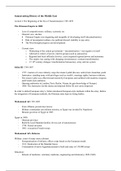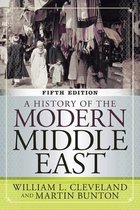Samenvatting History of the Middle East
Lecture 2 The Beginning of the Era of Transformation 1789-1839
The Ottoman Empire in 1800
- Loss of competitiveness: military, economic etc
- Oriental view: decline
Ottoman Empire was stagnating and incapable of developing itself (decentralization).
Rule of incompetent sultans, rise political discord, inability to pay army
The West brought progress and development
- Current view:
o Weakening of the central government = decentralization = not negative in itself
o Alternative centres of power, interest groups (such as janissaries)
o Regional and local officials (derebey, ayan) acquired regional power and autonomy
o The empire was coping with changing circumstances: constant transformation
o 17-18th-century changes: transformation bureaucracy, army and tax system
Selim III 1789-1807
- 1797: creation of a new infantry corps the nizam-I jedid (the new order) form Anatolian youth
- Janissaries: standing army with privileges such as wealth , marriage rights, business relations,
- The nizam I jedis was officered and trained by Europeans and outfitted with moderns weapons
and French-style uniforms
- Opening embassies in London, Paris, Berlin, Vienna (to gain knowledge of Europe).
- 1806: The Janissaries led the ulama and deposed Selim III, new army dispersed.
In order to defeat European army’s, Selim introduced European style methods within the army. Before
the integration of European methods, the Ottoman army kept on losing battles.
Muhammad Ali 1769-1849
- From Albania, present day Greece
- Military commander (on military mission, as Egypt was invaded by Napoleon)
- Became governor of Egypt in 1805
Egypt in 1800:
- Ottoman province
- Ruled by local Mamluk families (It was sort of autonomous)
- 1798: French invasion
- 1801: evacuation French troops
Muhammad Ali’s Reforms
Military: (start of many more reforms)
- Europeanization of military, officer corps based on the European model.
- 1811: Destruction of the Mamluk forces
- Conscription of native Egyptian peasant to built and army of 130.000 troops
Education:
- Schools of medicine, veterinary medicine, engineering and chemistry (1820-1840)
, - School of Languages to trains translations and the prepare Arabic textbooks (1835)
- Government printing press and first Arabic language newspaper )1828)
Administration:
- Reorganization of administration into a centralized bureaucracy
- Land reforms: confiscation of lands of tax farms, tax on waaf revenues
Economy:
- Public works project: irrigation system and mass production of cash crops, Jumel cotton
exported to Europe.
- Program of industrialization, particularly war materials and textiles for the local markets
- Monopoly system on raw materials.
Orientalism
Meanings:
- A body of scholarship, Oriental Studies
- Genre of art, works by 19th century European artists, who specialized in Oriental subjects
- The representation of the Orient in a stereotyped way
Orientalism according to Edward Said is a way of writing about the Middle East that is based on:
- A fundamental distinction between the East and West
- An unequal power relationship between the two
- The idea of Western authority to describe and analyze the East
- A Western style for domination, restricting and having authority over the Orient.
Wars of expansion ( not in detail in the exam)
• Arabia, 1811
- Ibrahim led a campaign to capture Mecca and Medina from under the Wahhabi movement
• Sudan, 1820
- Northern Sudan and the Red Sea came under Egyptian dominion.
• Syria, 1831-1832
- Muhammad Ali defeated the Ottoman forces
- Ibrahim served as governor of Syria from 1833 to 1840
• Treaty of London, 1841
- Muhammad Ali had to withdraw from all the territories he had occupied except the Sudan.
- Governership of Egypt heriditary
Sultan Mahmud II 1808-1839 (not in detail, just general)
Reform program:
- Creation of European style army corps and elimination of Janissaries in 1826
- New educational institutions
- Translation office
- Reorganization of the bureaucracy through European style ministries
- Limiting power of the ulama
- Making office of shayk al-Islam by making his office part of the state bureaucracy
- Acquire control of the waaf revenues by creating Ministry of Religious Endowments
The Tranzimat (reforms) period 1839-1876
,Most intensice phase of the 19th centry Ottoman reform
- Military improvements
- Higher education and an educational system outside the control of the ulama
- New legal based on French civil code, which included secular courts (nizame) and new civil
code (Mejelle)
- Two imperial decrees to create a notion of a common Ottoman citizenship, or Orromanism, to
replace the religious ordering of society and to secure the loyalty of Christian subjects of the
empire at a time of growing nationalism in the European provinces.
Two royal decrees
Hatti Sharif Gulhane 1839
- Administrative reforms (abolition of tax farming, elimination of corruption )
- Reforms would extend to all Ottoman subjects, regardless of their religion
Hatti Humayan 1856
- Repeated the principles of the 1839 decree and explicitly stated the guarantees of equality of
all subjects
- Muslim and non Muslims have equal obligations in terms of military service and equal
opportunities for state employment and admission to state schools.
This is an attempt to make the inhabitations loyal to the Empire, in order to keep the empire together,
as it was under fire because of nationalism.
The Greek Revolt 1821-1829
- Development of nationals in the Greek mainland
- It was an armed revolt in 1821, Egypt and Ottoman forces joined to combat the revolt in 1827
- Great Power intervention:
British public opinion was in favor of Greek cause
Russia sought to protect Greek Orthodox Church -> Treaty of Kucuk Kaynara 1774:
Russia became protector of the entire Greek Orthodox Church
- Britain and Russia avoided hostilities and postponed dismembering the Ottoman Empire: it
would remain as a buffer state between them
- 1832: Independent Greece
Young Ottomans
• A group of intellectuals and bureaucrats who contributed to the Ottoman literary renaissance
(poetry, periodical press).
• attempt to reconcile the new institutions of the Tanzimat (European-model institutions) with
the Ottoman and Islamic political tradition.
• called for the development of a more democratic form of government grounded in the Islamic
tradition.
• “Ottoman patriotism”: Islamic foundations of Ottoman society as ideological solution to the
problem of Ottoman territorial disintegration.
Namik Kemal insisted that all Ottomans ought to share feelings of devotion to the territorial empire
above any loyalties felt toward religious communities
The Ottoman Constitution 1876
• The 1876 constitution was a proclamation of Ottomanism and Ottoman patriotism.
- Allowed an elected chamber of deputies and an appointed senate
- Placed minimal restrictions on the sultan’s power
, - Reaffirmed the equality of all Ottoman subjects, including their right to serve in the
new chamber of deputies.
• some Ottoman elite believed a constitutional government would serve as a check on autocracy
• 1878: Sultan Abdul Hamid II dissolves the assembly, suspends the constitution
Economic developments
- Economies in Middle East were self-sufficient
- 1800: Integration Ottoman Empire in global market
- European market more competitive
- Commercial and industrial revolution in Europe
- Entrance of European merchant capital into the empire
- The provision of huge amounts of capital investments and access to credit
- Empire supplier of raw materials
- Empire consumed European goods -> therefore became dependent region
- 1838: Treaty of Balta Limani: abolition monopolies and creating tariff rates
- Loans from Europe led to the British occupation of Egypt and to loss of economic sovereignty
in the Ottoman Empire
The Ottoman Constitution of 1876
- 1876 constitution was a proclamation of Ottomanism and Ottoman patriotism:
Allowed an elected chamber of deputies and an appointed senate
Placed minimal restrictions on the sultan’s power
Reaffirmed the equality of all Ottoman subjects, including their right to serve in the new
chamber of deputies
- Some Ottoman elite believed a constitutional government would serve as a check of
autocracy
- 1878: Sultan Abdul Hamid II dissolves the assembly, suspends the constitution
Debt during Tanizmit period
- Expensive administrative programs and maintenance on a modern army
- annual budget deficits
- loans taken out on the European money markets.
- From 1854-1874, the Ottomans contracted 16 loans totally over 200 million Ottoman
lire.
- The increased level of debt meant that more funds had to be diverted from the
operating budget of the empire and, instead, used to pay interest on the loans.
- 1874: 60% of the state’s total expenditure was devoted to servicing the debt.
- 1876: The Ottoman Empire failed to make all of its debt payments to Europe, and was
essentially bankrupt.
- 1881: The European Decree of Muharram resulted in the establishment of an Ottoman
Public Debt Administration
Reforms years of Ismael
• Central government continued to broaden with new elite of officials
• increase state’s education budget, primary and secondary school systems, foundation technical
and vocational institutions.
• Egypt’s economic development became shaped by the needs of the European market.
• Egypt became integrated into the international economic order, exported raw materials
(cotton) and imported European manufactured goods.






